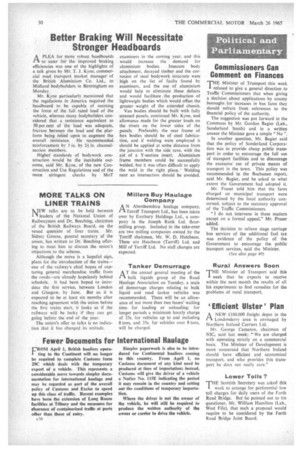Better Braking Will Necessitate Stronger Headboards
Page 32

If you've noticed an error in this article please click here to report it so we can fix it.
A PLEA for more robust headboards rA to cater for the improved braking efficiencies was one of the highlights of a talk given by Mr. T. J. Kyne, commercial road transport market manager of the British Aluminium Co. Ltd., to Midland bodybuilders in Birmingham on Monday. Mr. Kyne partioularly mentioned that the regulations in America required the headboard to be capable of resisting the force of the full rated load of the vehicle, whereas many bodybuilders considered that a resistance equivalent to 50 per cent of the load was adequate, friction between the load and the platform being relied upon to. augment the overall resistance. He recommended. reinforcement by 5 in. by 2+ in, channelsection members. .Higher standards of bodywork construction would be the inevitable outcome, said Mr. Kyne, of the new Construction and Use Regulations and of the more stringent checks by MoT examiners in the coming year, and this would increase the demand for aluminium bodies. Insecure body attachment, decayed timber and the corrosion of steel bodywork structure were high on the list of faults found by examiners, and the use of aluminium would help to eliminate these defects and would facilitate the production of lightweight bodies which would offset the greater weight of the extended chassis. Van bodies should be built with fully stressed panels, continued Mr. Kyne, 'and allowance made for the greater loads on the rivets on the lower sides of the panels. Preferably the rear frame of box bodies should be of steel fabrication, and if welding were employed it should be applied at some distance from the junction with the side rave, with the aid of a Y-section insert. Aluminium frame members could be successfully welded, but it was often difficult to apply the weld in the right place. Welding near an intersection should be avoided.




























































































































